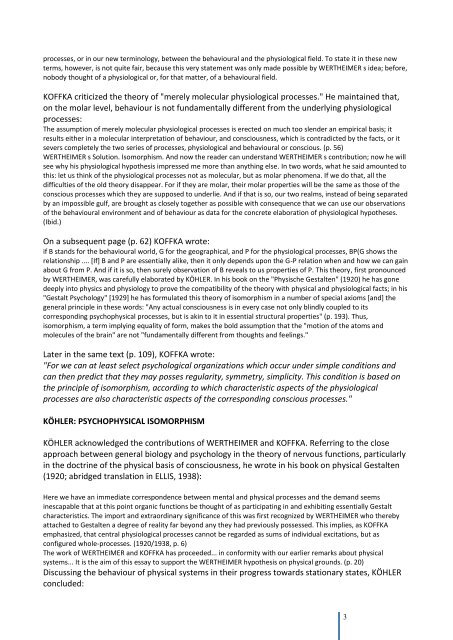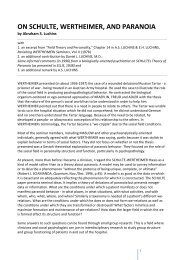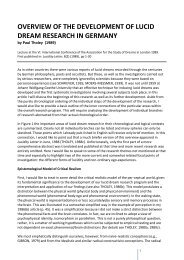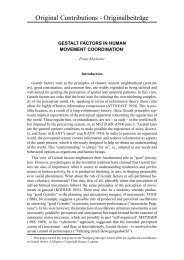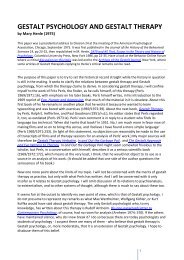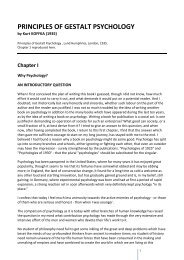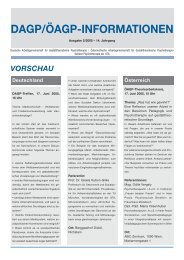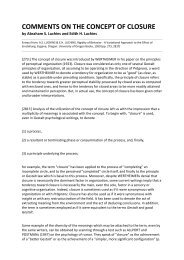pdf-Download - Society for Gestalt Theory and its Applications (GTA)
pdf-Download - Society for Gestalt Theory and its Applications (GTA)
pdf-Download - Society for Gestalt Theory and its Applications (GTA)
You also want an ePaper? Increase the reach of your titles
YUMPU automatically turns print PDFs into web optimized ePapers that Google loves.
processes, or in our new terminology, between the behavioural <strong>and</strong> the physiological field. To state it in these newterms, however, is not quite fair, because this very statement was only made possible by WERTHEIMER s idea; be<strong>for</strong>e,nobody thought of a physiological or, <strong>for</strong> that matter, of a behavioural field.KOFFKA criticized the theory of "merely molecular physiological processes." He maintained that,on the molar level, behaviour is not fundamentally different from the underlying physiologicalprocesses:The assumption of merely molecular physiological processes is erected on much too slender an empirical basis; itresults either in a molecular interpretation of behaviour, <strong>and</strong> consciousness, which is contradicted by the facts, or <strong>its</strong>evers completely the two series of processes, physiological <strong>and</strong> behavioural or conscious. (p. 56)WERTHEIMER s Solution. Isomorphism. And now the reader can underst<strong>and</strong> WERTHEIMER s contribution; now he willsee why his physiological hypothesis impressed me more than anything else. In two words, what he said amounted tothis: let us think of the physiological processes not as molecular, but as molar phenomena. If we do that, all thedifficulties of the old theory disappear. For if they are molar, their molar properties will be the same as those of theconscious processes which they are supposed to underlie. And if that is so, our two realms, instead of being separatedby an impossible gulf, are brought as closely together as possible with consequence that we can use our observationsof the behavioural environment <strong>and</strong> of behaviour as data <strong>for</strong> the concrete elaboration of physiological hypotheses.(Ibid.)On a subsequent page (p. 62) KOFFKA wrote:if B st<strong>and</strong>s <strong>for</strong> the behavioural world, G <strong>for</strong> the geographical, <strong>and</strong> P <strong>for</strong> the physiological processes, BP(G shows therelationship .... [If] B <strong>and</strong> P are essentially alike, then it only depends upon the G-P relation when <strong>and</strong> how we can gainabout G from P. And if it is so, then surely observation of B reveals to us properties of P. This theory, first pronouncedby WERTHEIMER, was carefully elaborated by KÖHLER. In his book on the "Physische <strong>Gestalt</strong>en" (1920) he has gonedeeply into physics <strong>and</strong> physiology to prove the compatibility of the theory with physical <strong>and</strong> physiological facts; in his"<strong>Gestalt</strong> Psychology" [1929] he has <strong>for</strong>mulated this theory of isomorphism in a number of special axioms [<strong>and</strong>] thegeneral principle in these words: "Any actual consciousness is in every case not only blindly coupled to <strong>its</strong>corresponding psychophysical processes, but is akin to it in essential structural properties" (p. 193). Thus,isomorphism, a term implying equality of <strong>for</strong>m, makes the bold assumption that the "motion of the atoms <strong>and</strong>molecules of the brain" are not "fundamentally different from thoughts <strong>and</strong> feelings."Later in the same text (p. 109), KOFFKA wrote:"For we can at least select psychological organizations which occur under simple conditions <strong>and</strong>can then predict that they may posses regularity, symmetry, simplicity. This condition is based onthe principle of isomorphism, according to which characteristic aspects of the physiologicalprocesses are also characteristic aspects of the corresponding conscious processes."KÖHLER: PSYCHOPHYSICAL ISOMORPHISMKÖHLER acknowledged the contributions of WERTHEIMER <strong>and</strong> KOFFKA. Referring to the closeapproach between general biology <strong>and</strong> psychology in the theory of nervous functions, particularlyin the doctrine of the physical basis of consciousness, he wrote in his book on physical <strong>Gestalt</strong>en(1920; abridged translation in ELLIS, 1938):Here we have an immediate correspondence between mental <strong>and</strong> physical processes <strong>and</strong> the dem<strong>and</strong> seemsinescapable that at this point organic functions be thought of as participating in <strong>and</strong> exhibiting essentially <strong>Gestalt</strong>characteristics. The import <strong>and</strong> extraordinary significance of this was first recognized by WERTHEIMER who therebyattached to <strong>Gestalt</strong>en a degree of reality far beyond any they had previously possessed. This implies, as KOFFKAemphasized, that central physiological processes cannot be regarded as sums of individual excitations, but asconfigured whole-processes. (1920/1938, p. 6)The work of WERTHEIMER <strong>and</strong> KOFFKA has proceeded... in con<strong>for</strong>mity with our earlier remarks about physicalsystems... It is the aim of this essay to support the WERTHEIMER hypothesis on physical grounds. (p. 20)Discussing the behaviour of physical systems in their progress towards stationary states, KÖHLERconcluded:3


